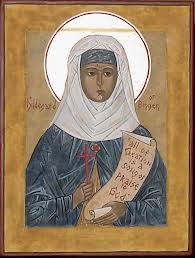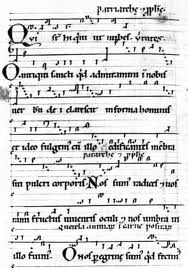 The other day, Google ran a Doodle in honor of 19th-century composer/pianist Clara Schumann’s birthday, and it took me back to my days as an undergraduate music major. Yes, it’s true—before I was Miss History ‘n’ Pop Culture, I was studying to be a composer. I switched gears, but I still harbor a deep passion for music, and I still play piano. Mostly show tunes.
The other day, Google ran a Doodle in honor of 19th-century composer/pianist Clara Schumann’s birthday, and it took me back to my days as an undergraduate music major. Yes, it’s true—before I was Miss History ‘n’ Pop Culture, I was studying to be a composer. I switched gears, but I still harbor a deep passion for music, and I still play piano. Mostly show tunes.
Anyway, I was reminded how, in my music history studies, of the dozens and dozens of important names we learned, there were maybe three female composers that came up. There was Clara Schumann---wife of Robert Schumann. There was Fanny Mendelssohn---sister of Felix Mendelssohn. But the one who always stood out for me—maybe because she stood entirely on her own—was Hildegard von Bingen, a Benedictine nun from the twelfth century who wrote, of all things, monophonic morality plays. Fun!
Saint Hildegard (she was “equivalently canonized” earlier this year) was another one of those historical women who seemed to do it all, with the added benefit of living an uncommon 82 years in medieval times. She was born in 1098 in Germany, and as a teenager, she was instructed in psalm-reading by the head of a local Benedictine community. When the woman died, Hildegard was elected the new head.
I should mention---Hildegard had been having these visions ever since she was a child, which she often described as in terms of bright lights. Modern-day physicians would attribute these “visions” (and the visions of many other medieval mystics) to migraines, hence the light sensitivity, which, all in all, is a perfectly satisfactory explanation. But I’d caution against getting too wrapped up in modern scientific understandings of things; for Hildegard, these visions were real, as they also were for many of those who surrounded her. And their very “realness” was the impetus for many of the great things she accomplished.
It was at age 42 when Hildegard had THE vision, the first one that would serve as the divine inspiration for her work. “A burning light of tremendous brightness coming from heaven poured into my entire mind,” she recorded. “God told me, ‘Write what you see and hear.’” And, in the Middle Ages, when God talked, you listened.
From then on, Hildegard was a writing fiend. She would produce a book on theology, two books on science and medicine, over seventy musical pieces, and go on four speaking tours of Europe. She did this all while recording her visions and managing her convents. Notably, she also held regular correspondence with kings and popes and important dudes like Abbot Suger, not easy guys to impress.
This story, I think, illustrates what she was able to achieve very well: In 1148, Hildegard claimed she had been commanded by God to move her nuns to a new location near the town of Rupertsberg. The monks over her head refused, wary of the expense and the loss of personnel. Hildegard then took to her bed, struck sick, too weak to move. Her sickness was, of course, attributed to her failure to follow God’s divine orders. Eventually, the abbot agreed with this interpretation and granted her permission to move to the new site, overruling the monks, and Hildegard got what she wanted. And within a few years, the Rupertsberg convent became so popular they needed to build a second convent just across the Rhine River to accommodate demand. Hildegard managed both.
It’s been noted that, despite her gender, Hildegard didn’t quite jibe with modern feminist ideas—that she sometimes spoke ill of women, associating them with weakness in accordance with dominant ideas of the time. Unlike her male contemporaries, she didn’t toot her own horn when it came to her musical talents, considering herself a mere vessel for the voice of God. (Note: This wasn’t an idea particular to Hildegard or women, however; Jorge Luis Borges notes that writers of antiquity such as Plato considered the poet nothing more than a “fleeting instrument of divinity.”)
But Hildegard’s attitude needs to be placed in its appropriate context, as do her migraine-visions. In fact, they’re kind of related. Much of Hildegard’s power was derived from her claims to legitimate communion with God; this was an incredibly effective means to personal agency in the Christian-dominated paradigm of medieval Europe. Her visions, her orders from heaven, her illnesses were tools from which she could carve out an autonomous space, provoke action from male higher-ups, and, ultimately, leave her mark on music history, religious history, and medieval history, something so few other women were able to achieve.
This is not in any way to say that Hildegard’s successful maneuverings within the system were planned or intentional. But it’s worth noting that, of the privileged few medieval women from the lower (read: not queen) classes who show up on the historical record, a large number were saints and mystics. There was no feminism in 1150. You did what you could.
In honor of St. Hildegard, who according to Wikipedia celebrated a birthday on Sunday (happy 914th!), I recommend listening to one of her lovely compositions, like Spiritus Sanctus or O vis aeternitatis. Though solemn and ordered by today’s standards, for her time she was very original, breaking many of the hallowed rules of music theory to write soaring vocal lines and even (gasp!) switching modes in mid-song. For perspective, mode-switching didn’t become a la mode until five hundred years later.
Kinda makes you want to go join a medieval convent, doesn’t it? Or at least write a pretty song with a hurdy gurdy in it. I might just go do the latter.


